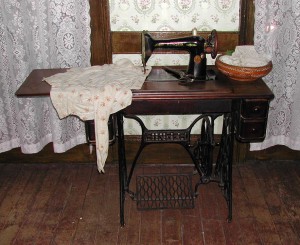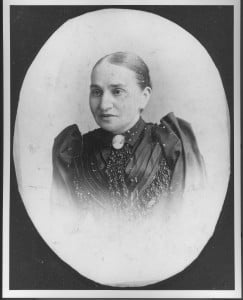Blog Archive
For Richer or Poorer: A Brief History of Charity & Immigration in NYC
In the sparsely-furnished front room of the Gumpertz apartment at The Lower East Side Tenement Museum, in between the windows, sits a small, black Singer sewing machine. In the wake of the panic of 1873, with jobs hard to come by and with four children to feed, Nathalie Gumpertz would not have been able to afford such a major purchase on her own. Instead, the sewing machine, which allowed Nathalie to support her family in the face of economic hardship, was most likely purchased with money from (or even donated by) United Hebrew Charities, whose ledgers record Nathalie as a recipient.
Many of the immigrants who passed through 97 Orchard Street received aid of various kinds in times of crisis from their friends and neighbors, mutual aid associations, local parish churches, political machines, and even the occasional government program. More established or earlier-arriving immigrants have historically offered some financial support for newer settlers from their communities. The Jewish communities in New York are a perfect example of this trend. For Jewish immigrants, charity had always been a core value of Jewish life; the biblical ideal, tzedakah in Hebrew, translates to “righteousness” or “justice,” and connotes “obligation” to give money and material to support others, rather than seeing it as an optional kindness. But those who gave to the United Hebrew Charities saw their work as more than just fulfilling an obligation to help other Jews in need. Concerned with what their neighbors Uptown might think, these early American Jewish philanthropists often gave money to “maintain Jewish families,” hoping to discourage men from abandoning their families, women from engaging in prostitution, and parents from neglecting their children. They knew that a Russian Jewish prostitute or a Polish Jewish gangster was just a Jewish criminal to the upper classes, who made no such distinctions.
Although the Gumpertz family did not arrive in New York until the mid-19th century, about the same time that United Hebrew Charities was founded, American Jewish philanthropy had its roots in the early colonial era. As American Jewish mythology had it, Jews were allowed to settle in the U.S. on the express condition that they provide for their own poor, and never allow them to become a burden on the non-Jewish community. As a result, American Jews created their own sectarian aid institutions, which quickly turned to the material relief and vocational training of new immigrants to the U.S. By the time that Nathalie received aid, she was among the last major generation of German immigrants to get help from United Hebrew Charities and similar organizations. By the turn of the 20th century, most Jewish charities were meant for new Eastern European and Russian immigrants, funded and run by the Americanized German Jews whose ancestors had immigrated decades earlier. As the Jewish community in America became more diverse, these newer immigrants sought to become philanthropists themselves, sending aid to relatives and friends in their former hometowns. They frequently created landsmanshafn, organizations of families who had emigrated from the same city or village, to serve as mutual aid societies and as fundraising organizations for projects and charities in their former homes.
By the 20th century, charity meant much more than a simple donation to the United Hebrew Charities. Rich, poor, immigrant, or not, Americans were all of a sudden faced with hundreds of causes and organizations competing for their charity dollars. The decision of where to donate became a way to vote with dollars, demonstrating political, religious, and social commitments. For newer immigrants, the very ability to send money overseas to friends and relatives who depended on it was empowering; though many of them struggled to make a living in the U.S., their pennies had disproportionate influence in their hometowns, especially when combined with those of the other immigrants from their region. Ultimately, philanthropy helped even poorer immigrants to create a new identity for themselves in America: the donor with the power to choose how his money was spent.
For those giving money to support causes they cared about, donations also promoted a new kind of unity, one that helped to create a feeling of communal responsibility amongst Americans, old and new. Without a welfare state or official church to provide medical care and housing for the needy or to feed the hungry, Americans had to step in to support those around them. Despite differences in origin, religion, language, and ideology, extending a helping hand created mutual responsibility and community. By participating in private philanthropy – a uniquely American tradition – they helped to create an American identity for themselves.
Ultimately, while the donations themselves had a profound impact on those they were meant to help (Nathalie Gumpertz remained an upstanding citizen!), they also had a profound impact on those who were doing the giving. Donations and charity work helped to link disparate communities together and to give newcomers a political voice. In America, giving has always been form of self-creation, a way for the giver to make a statement – about who you are, what you value, and what kind of world you envision.
– Post by Rachel Feinmark, Manager of Strategic Communications at The Lower East Side Tenement Museum
The advent of social media-driven fundraising campaigns has only made this more true today. This Tuesday, the Tenement Museum invites you to make your own statement – donate to our #GivingTuesday campaign and tell us about the kind of change you hope to see in the world.
![]()

